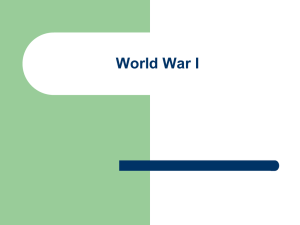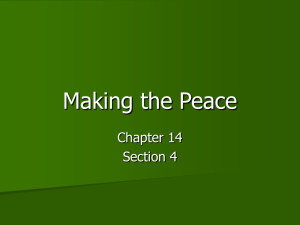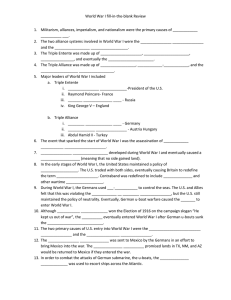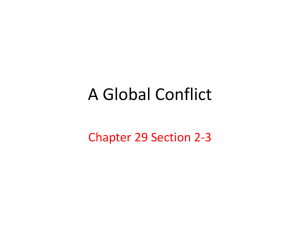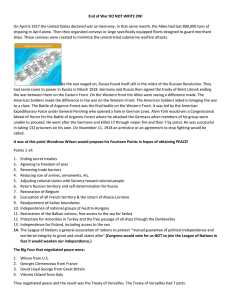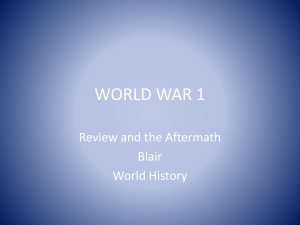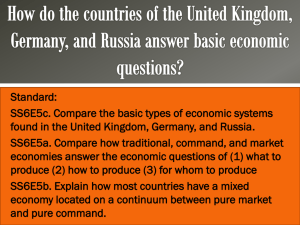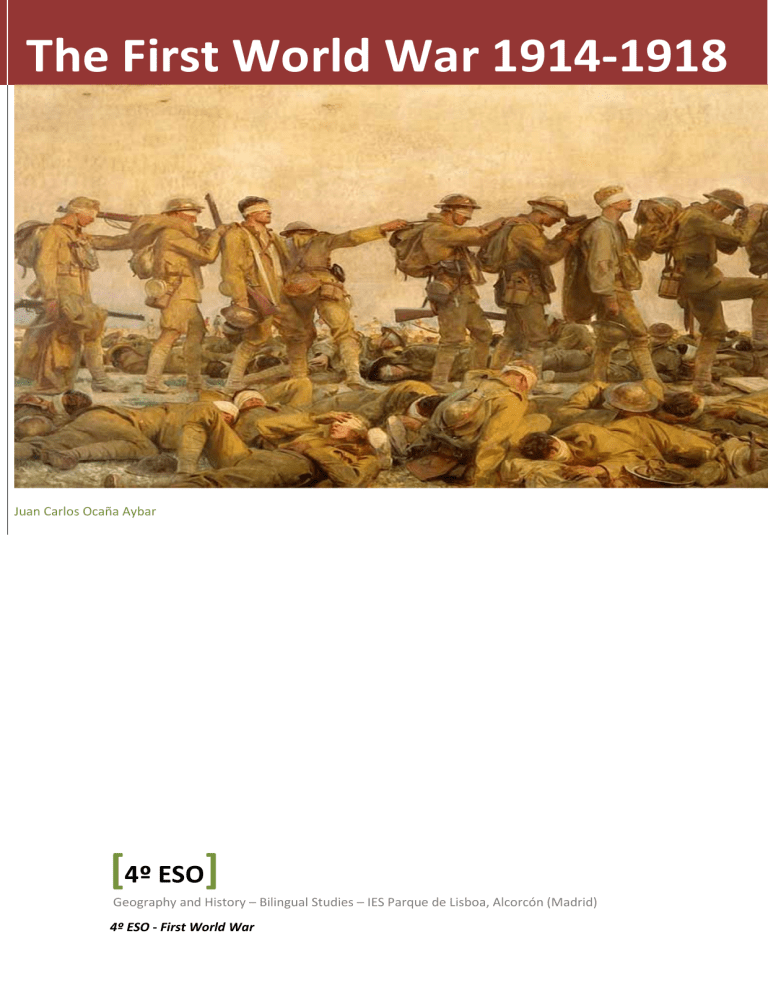
The First World War 1914-1918 1 Juan Carlos Ocaña Aybar [4º ESO] Geography and History – Bilingual Studies – IES Parque de Lisboa, Alcorcón (Madrid) 4º ESO - First World War 2 The First World War (1914-1918) Introduction The photos of the summer of 1914 now stun the observer. Young people across Europe are heading toward war as if they were marching to a big party. Everyone thought the war would be a fast and short conflict, in which, of course, his nation would win, demonstrating its power. British young men queuing up at an Army recruiting office The reality was quite different. The Great War was a war completely different than what previous generations had known. Soldiers from around the world, in Europe and its colonies, the U.S., Japan ... fought on fronts that were located in the heart of Europe and in remote and exotic lands. In addition, the industrial powers were able to utilize their technologies to work for the war. The result was devastating. The suffering of the civilian population and soldiers reached limits that no one could conceive of in 1914. British soldiers blinded after a gas attack 4º ESO - First World War 3 Text: The warmongering atmosphere in Germany before the war "France is not yet ready for combat. Britain faces interior and colonial difficulties. Russia rejects war, because she fears the revolution within. Are we going to wait for our opponents to be prepared or, rather, should we take advantage of the favourable moment to cause the decision? This is a serious issue to be settled. The Austrian army is still faithful and useful. Italia is still strongly linked to the Triple Alliance and even if it prefers (...) keep the peace to heal the wounds of the last war, she knows (...) that if Germany is defeated, it will remain hopelessly at the mercy of France and England’s violence and it will lose its independent position in the Mediterranean (...) We can also, in case of war, count on Turkey and Romania (...) We could lead the direction of the European policy through a resolute offensive, and we secure our future. This does not mean that we should provoke war, but wherever a conflict of interest turns out (...) we should not go back, but solve it by means of war and start it with a resolute offensive, no matter the excuse, because it is not that conflict, but our future what is at stake. " Text analysis ● ● ● ● ● Read the text carefully and look up every word or term you do not fully understand Which countries are the possible enemies and allies of Germany in a future war? What was the enemies’ situation like? What was the allies’ situation like? According to this article, what should Germany do in 1914 to lead the European policy? Explain it in detail. 4º ESO - First World War 4 1. Causes of the War The factors that explain the outbreak of the First World War are varied. These are the main ones: ● The new international expansionist policy undertaken by the German Emperor Wilhelm II in 1890. ● The change in the power balance between economic powers, with Britain frightened before the German industrial might and the naval rearmament, which was initiated by the government of Berlin. ● Conflicts between colonial powers in Africa and Asia. ● Territorial rivalry between France and Germany for the regions of Alsace and Lorraine. ● Rivalry between Russia and Austria-Hungary for the hegemony in the Balkans. A new factor also needed to be added up to the above mentioned: non-European countries like the U.S. and Japan rising to the rank of world powers. Let’s examine in a more detailed way these factors that caused the war. The Great Powers of the World in 1914 4º ESO - First World War 5 Causes of the First World War In 1890 the new emperor of Germany, Wilhelm II, began an international policy that sought to turn his country into a world power. The Weltpolitik ("world politics") Germany was seen as a threat by the other powers and destabilized the international situation. In addition to the new German policy, there were other changes that radically altered the world as it journeyed from the nineteenth to twentieth century: ● ● The second industrial revolution, which began in 1870, shifted the balance of economic might between the powers. The increasingly powerful Germany challenged British hegemony. This challenge was particularly seen in two areas: increasing competition of the German economy and the acceleration of the German naval rearmament As we saw earlier, the extension of the colonial empires exacerbated the struggle for territory, markets, prestige and power between the European industrial powers. Admiral Von Tirpitz and German naval rearmament In this context, territorial rivalries between the European powers intensified. Two particularly serious clashes took place: ● The Franco-German rivalry, unavoidable since the annexation of Alsace-Lorraine by Germany in 1870 4º ESO - First World War 6 France, longing for lost Alsace, promises to abolish the Treaty of Frankfurt 1871 which meant the German annexation ● The rivalry between Russia and Austria-Hungary for hegemony in the Balkans increased by the increasing weakness of Turkey and Slavic (Serb mainly) nationalism encouraged by Russia and directed against the Habsburgs in Vienna Austria and Russia fighting for seizing former Turkish Balkans 4º ESO - First World War 7 ● Psychological rivalry between peoples, encouraged by nationalist propaganda campaigns. Hatred of the neighbor was more the norm than the exception. Germany devouring the world ● Finally, two non-European powers, the US and Japan, joined the group in the world hegemonic powers. The new war would have a global dimension. Formation of alliances and conflicts preceding the final crisis In the years before the war, the powers were forming military alliances to defend their objectives: ● The Triple Alliance linking Germany with Austria-Hungary and Italy. It was signed in 1882, in the days of Chancellor Bismarck. The German Reich and the Austro-Hungarian Empire constituted the core of this alliance. The German emperor, the Italian king and the Austrian emperor 4º ESO - First World War 8 ● The Triple Entente, which was made up of Britain, France, and Russia, concluded by 1907. The increasing German aggression led to Britain and France ending their colonial differences. The rivalry between Austria-Hungary and Russia in the Balkans pushed Russia into the alliance. Entente’s propaganda poster During the decade before the war, four successive international crises marked the evolution toward a widespread conflict. Two took place in Morocco where Germany and France clashed. Two occurred in the Balkans, Russia and Austria-Hungary fought to replace Turkey as the hegemonic power. The final crisis took place on June 28, 1914 when the Archduke Franz Ferdinand, heir to the Austro-Hungarian throne, was assassinated in Sarajevo (Bosnia). An activist Bosnian Serb, Gavrilo Princip, a member of the Serbian nationalist organization "Black Hand" killed the Archduke. The alliances started working and it led from a local conflict to a general war in Europe and the world. 2. The Road to World War I ● 1882: Triple Alliance. Bismarck, German Chancellor (1871-1890) and skilled diplomat, built a complex web of international treaties whose key element was the Triple Alliance or Triple Alliance (1882) linking Germany with Austria-Hungary and Italy. Its main goal was keeping France, the enemy defeated in 1870, isolated. ● 1888: William II, new Kaiser of Germany. The arrival in 1888 to the throne of the new German Kaiser, Wilhelm II, changed dramatically the international situation. After dismissing Bismarck in 1890, Germany launched a new international policy, more ambitious and aggressive (Weltpolitik) than Bismarck’s, that quickly triggered defensive reactions from other powers who felt threatened before the new German foreign policy. ● 1893: Franco-Russian Alliance. The aggressive policy of Kaiser Wilhelm II led to the signing of a military agreement, which established mutual military assistance against 4º ESO - First World War 9 Germany, between two very different powers: Tsarist Russia and republican France. This alliance meant the definitive end of diplomatic systems designed by Bismarck: France had got out of their isolation ● 1904: Franco-British Entente Cordiale. Thanks to its economic, naval and colonial hegemony, for a long time the UK did not need to sign alliances with other European powers (“splendid isolation”). However, the German Weltpolitik was such a great challenge that it forced London to seek international agreements. So, after resolving their colonial disputes, France and Britain signed the Entente Cordiale beginning a period of Franco-British cooperation against German aggression. ● 1905-1906: The first Moroccan crisis. William II, on a visit to Tangiers, Morocco, proclaimed the German opposition to French colonization of Morocco. This challenge precipitated the convening of an international conference in Algeciras (1906). At this conference, Germany was isolated and France had a clear British support. The Entente Cordiale worked ● 1907: Anglo-Russian agreement. Under pressure from France, an ally of both powers, and growingly suspicious of German expansionism, Britain and Russia finally settled their colonial differences in Central Asia. This agreement laid the foundations of one block that would fight in WW1. ● 1908: Austro-Hungarian annexation of Bosnia-Herzegovina. Taking advantage of internal difficulties in Turkey, Austria-Hungary annexed Bosnia-Herzegovina. As Germany strongly supported its ally, Russia was forced to yield to the Austrian aggression and did not face the Austrian-Hungarian challenge. At that time, neither France nor Britain were willing to support Russia in a possible conflict in the Balkans ● 1911: The incident of Agadir in Morocco. Sending a German gunboat to the harbor of Agadir in Morocco, Berlin unleashed a diplomatic crisis. Although eventually there was a diplomatic agreement that ended the crisis, the Agadir incident highlighted the growing Franco-German confrontation. ● 1912-1913: The Balkan Wars. Two successive Balkan wars that involved Turkey, Serbia, Greece, Montenegro and Bulgaria concluded with the Treaty of Bucharest in 1913. The wars caused a shift in the situation in that area. Turkey was reduced in the Balkans to a small region around Istanbul. Serbia (Russia's ally and defender of the rights of the Slavs in the Austro-Hungarian Empire) was consolidated as the leading state in the region. Austria-Hungary was upset by the strengthening of Serbia and came to the conclusion that only a preventive war would prevent Serbia from leading a general uprising of the Slavic people in the Habsburg Empire, who would be encouraged by the great Slavic power, Russia. Russia eventually was determined to intervene when Austria-Hungary attacked Serbia ● 1914: The assassination of Sarajevo. June 28, 1914 Archduke Franz Ferdinand, heir to the Austro-Hungarian throne, was assassinated in Sarajevo (Bosnia). Gavrilo Princip, a member of the Serbian terrorist organization "Black Hand" was the assassin. The 4º ESO - First World War 10 attack triggered a fatal series of events that led to the war. Powers faithfully fulfilled its diplomatic commitments and the crisis quickly went from a local incident to a general war in Europe. ● 1914: The start of the war. The terrorist attack in Sarajevo was the spark that started the fire of the First World War. This is a summary of the sequence of events that led to war. Date 28th June 23th July 28th July 30th July 1st August 3rd August 4th August Event Sarajevo terrorist attack After ensuring the support of Germany, Austria-Hungary gave an ultimatum to Serbia Austria-Hungary declared war on Serbia Russia started the general military mobilization Germany declared war on Russia. France started the general military mobilization. Germany declared war on France Germany invaded Belgium, what caused the British declaration of war against Germany 4º ESO - First World War 11 Throughout the war, several states joined the two blocs in the conflict. New accessions had a key role in defining the victor of the war. These were the main combatants and the year in which they went to war. Year Entente or Allies Central Powers August 1914 Russia France Britain Belgium Serbia Japan Italy Romania USA Greece Soviet Russia left the war and signed a peace treaty with Germany Austria-Hungary Germany 1914 1915 1916 1917 1918 The Alliances at the beginning of the war 4º ESO - First World War Turkish Ottoman Empire Bulgaria 12 3. Phases of the War The conflict developed on several fronts in Europe, Africa, and Asia. The two main scenarios were the Western front, where the Germans confronted Britain, France and, after 1917, the Americans. The second front was the Eastern front in which the Russians fought against Germans and Austro-Hungarians. After a brief summer German advance in 1914, the western front was stabilized and a long and brutal trench warfare started: it was a "war of attrition". Meanwhile on the Eastern Front the Germans advanced but not decisively. In 1917, two events changed the course of the war: the United States joined the Allies and Russia, after the Soviet revolution, abandoned the conflict and sign a separate peace. Finally after the German offensive in the spring of 1918, the Allied counterattack managed to force a decisive retreat of the German army. The defeat of its Germany’s allies and the revolution in Germany that dethroned the Kaiser, brought about the signing of the armistice on November 11, 1918. The Great War was over. Let’s see in a more detailed way the stages of the war. 1914: The war of movement At the beginning of the conflict, no one expected a war that would stretch for more than four years. Naive soldiers even smiled on their way to the front lines and military headquarters made plans expecting a quick and easy defeat of the enemy. At the beginning, the Germans implemented the so-called Schlieffen Plan: they attacked France through neutral Belgium to get a quick defeat of the French army. This would allow German troops to turn against Russia before the Tsar could mobilize his massive army. Schlieffen Plan 1914 4º ESO - First World War 13 The French, however, managed to stop the German attack in the Battle of the Marne, in the fall of 1914, and the Russians also halted the German advance in the east. The Western Front was stabilized along thousands of kilometers and soldiers dug trenches preparing for a long war. 1915-1916: The war of attrition The confrontation between major industrial powers led to war at a level of violence and horror never before contemplated. The invention of new weapons (grenades, flamethrowers, tanks, toxic gas) and the use of machine gun led to systematic and great massacres, which, however, did not break the tactical tie on the Western Front. The war spread to several fronts. The Western Front (France-Germany) and the Eastern Front (Russia) accounted for the bulk of the operations. Apart from these two main fronts, the fighting took place on other minor fronts: the Alps (Italy), the Balkans and the Middle East. On the Western Front Germans fought against French and British in a long series of terrible battles that did little to break the front. The Battle of Verdun was the biggest example of what the German generals called the "war of attrition". Throughout 1916, heavy fighting took place around the French city of Verdun. More than 700,000 soldiers were killed but the front remained immovable. Something similar happened in the battles of Ypres and the Somme… German soldiers in Verdun 1916 4º ESO - First World War 14 1917: The Tipping Point of the War Two great events came to turn the tide of the war in 1917: the U.S. entry into the war in April and Russia out of the conflict in December. United States had remained neutral in the conflict but had supplied the Entente countries. The Germans decided to undertake submarine warfare, a risky tactic of attacking and sinking not only British or French ships but also attacking neutral shipping. The sinking of several American ships, with the consequent loss of lives eventually led President Wilson to declare war on the Central Powers. Popular discontent with the progress of the war in Russia culminated in a revolution that overthrew the Tsar in March and brought to power the Bolsheviks (Communists) in November. Lenin's new government signed the armistice with the Central Powers in December. Russia left the war. In March 1918, Russia signed the Treaty of Brest-Litovsk with the Central Powers, yielding large territories. 1918: The Aftermath The leaving of the war by revolutionary Russia allowed Germany to concentrate their forces on the Western Front. The summer of 1918 witnessed the last desperate German attacks. However, Germany was practically alone. His allies were on the verge of military and economic exhaustion. The arrival of U.S. troops in Europe balanced the scales in favor of the Entente. Bulgaria asked the armistice in September, Turkey in October and Austria-Hungary surrendered in early November. 4º ESO - First World War 15 In Germany, a revolution overthrew Wilhelm II, who had to flee to Holland. The new democratic regime had to sign the German armistice on November 11, 1918. The war was over. Text: The Western Front “That was the "Western Front", which probably became more deadly machinery until then he had known the history of warfare. Millions of men faced from the parapets of the trenches formed by sandbags under where they lived like rats and lice (and with them). Occasionally, his generals were trying to end this impasse. For days, or weeks, artillery performed incessant bombardment (...) to "soften up" the enemy and force to protect themselves in underground shelters until at the right moment waves of soldiers jumped over the parapet, protected by barbed wire, to the "no man's land," a chaos flooded with shells, fallen trees, mud and abandoned corpses, to move against machine guns, that they knew were going to reap their lives. In 1916 (February to July) the Germans tried unsuccessfully to break the defensive line at Verdun in a battle that pitted two million soldiers and in which there were a million casualties. The British offensive on the Somme (...) cost Britain 420,000 dead (60,000 only the first day of the battle). Not surprisingly, for the British and the French (...) that was the "great war", the most terrible and traumatic part of WWII.” Eric Hobsbawm, History of the Twentieth Century, 1995, Critical Text analysis ● ● ● Carefully read the text and look up every word or term you do not fully understand Using your own words, describe a typical attack in the Western Front Investigate one of the main battles in the Western Front and write a short half-page description, including some pictures. 4º ESO - First World War 16 4. The Peace Treaties On January 18, 1919, representatives of the victorious countries met at the Conference of Paris, under the direction of the Committee of Four: U.S. President Wilson, British Prime Minister Lloyd George, French Prime Minister Clemenceau, and Italian Chief Executive Orlando. Lloyd George, Orlando, Clemenceau and Wilson in Versailles Representatives of the defeated countries were not invited to the peace conference. The victorious countries negotiated the treaty and they demanded strict penalties against the defeated countries. Since the defeated countries did not participate in the negotiation, it was presented to them as a fait accompli. In other words, they had no choice but to accept and they could not make any changes. The German representatives of the fledgling democratic Weimar Republic, signed the treaty on 28 June 1919, under threat of a total invasion of their country if they did not sign. In Germany, there was talk of diktat, the imposition of Versailles. The victorious countries signed different peace treaties with each of the various defeated nations: the Treaty of Versailles with Germany, the Treaty of Saint-Germain with Austria, the Treaty of Trianon with Hungary, the Treaty of Neuilly with Bulgaria and on the treaty of Sevres and later Lausanne treaty with Turkey. The Treaty of Versailles The position of the victors following the end of the war was different. Clemenceau personified a harder stance with Germany. Clemenceau, the French leader, insistently claimed that "Germany will pay". British and Americans were willing to punish Germany, however, they opted for a more conciliatory attitude. Finally, Italy, who were less interested in the fate of Germany, tried unsuccessfully to obtain new territory. 4º ESO - First World War 17 The Treaty of Versailles is organized in several chapters which each have different clauses. Territorial clauses: ● ● ● ● ● ● France regained Alsace and Lorraine Eupen and Malmedy passed into the hands of Belgium Eastern territories were annexed by Poland which caused East Prussia to become territorially isolated. Danzig and Memel, former Baltic German cities were declared free cities Denmark annexed northern Schleswig-Holstein Germany lost all of its colonies and the victors annexed them Military clauses: ● ● ● Drastic limitation of the German navy. Dramatic reduction of the Army (only 100,000 troops, prohibition of having tanks, aircraft and heavy artillery). Demilitarization of the Rhineland region. War Reparations: The treaty declared Germany and its allies responsible for all 'loss and damage' suffered by the Allies and as a consequence they were forced to pay war reparations to the victors. 4º ESO - First World War 18 The London Conference of 1920, established the total amount of repairs that had to be paid by Germany: 140.000 million gold marks, an enormous amount for the time. At the Spa Conference, also in 1920, the 140.000 million gold marks were divided into a fixed percentage and given to each country: France received 52%, Britain 22%, Italy 10%, and Belgium 8%. Other Treaties The Treaty of Neuilly, signed with Bulgaria. The small Balkan country suffered several territorial losses, in the benefit of Romania, Greece and a brand-new country: Yugoslavia. The Treaty of Sevres (1920), signed with Turkey, and then fixed in the Treaty of Lausanne in 1923. The Treaty of Sevres was extremely hard and led to the Turkish national rebellion, which was led by Kemal Ataturk. This also lead to the war against Greece, which occupied large areas of Anatolia. After the Turkish victory in the Greek-Turkish war, the Treaty of Lausanne was signed. This treaty was much more benign, but concentrated the distribution of Turkish possessions in the Middle East between France (Syria, Lebanon) and Britain (Palestine, Iraq, Jordan). The Treaty of Saint Germain, signed with Austria. This treaty led to the disintegration of the Austro-Hungarian Empire. The break-up of this old empire resulted in the creation of new states, such as Austria, Hungary and Czechoslovakia. On top of that, several sections of the former empire were annexed by new states such as Poland and Yugoslavia. The Treaty of Trianon, signed with Hungary. Hungary was probably treated the worst after the war. Large Hungarian minorities (3 million people, equivalent to one third of the Hungarian population total) were left outside of the Hungarian state, living as minorities in Czechoslovakia, Romania (Transylvania) and Yugoslavia. All the defeated countries, like Germany, were forced to pay damages and to limit the strength of their armies. The outcome of the Russian revolution: new states in Central and Eastern Europe Furthermore, as a result of the Soviet revolution and the collapse of Tsarist Russian Empire, new states were born in Central and Eastern Europe: ● Poland, reborn from Russian, German and Austro-Hungarian territories. ● Finland, Estonia, Latvia, and Lithuania, which were former regions of the Russian Empire. 4º ESO - First World War 19 These treaties, rather than solving the problems that had led to the Great War, caused increased tensions in Europe. The most important was the German problem. Many Germans began to bide their time to get revenge against the “diktat”, the “humiliation” of Versailles. (Treaty of Versailles) 5. The Consequences of the War The world that emerged after the catastrophe of 1914-1918 was very different from the prewar. The most obvious were the terrible loss of life: eight million dead, millions wounded people, maimed, widows and orphans, and the material destruction suffered especially by Europe. However, the war also brought other important social and ideological changes. 4º ESO - First World War 20 ● The U.S., which had won the war but had not experienced the conflict on its territory, became a first world power. ● The mass mobilization of men led to the incorporation of women into the work force, which was a major step forward for women's rights. ● The triumph of the Soviet Revolution and the social crisis that followed the war encouraged workers in many countries to protests, creating a pre-revolutionary climate. ● The extreme nationalism experienced during the war, coupled with fear of a Communist revolution, encouraged the middle-class populations of some countries to move to the extreme right. This created a hotbed of fascist movements. 4º ESO - First World War
